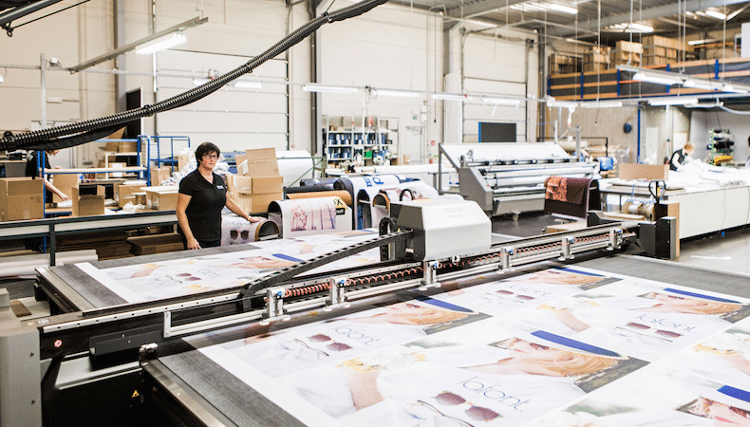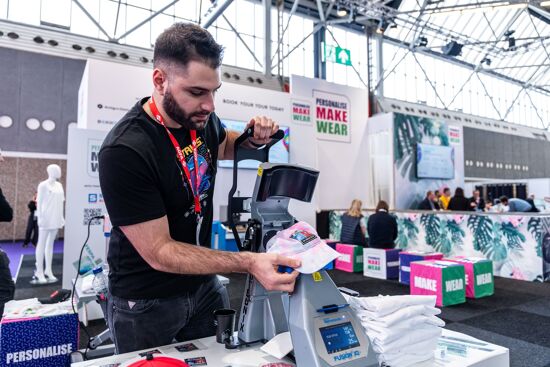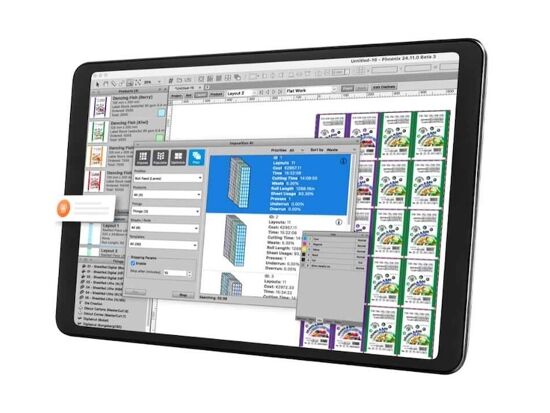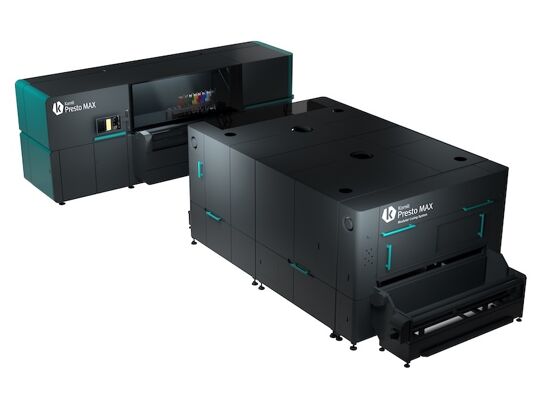Visix relies on Esko to increase throughput

Belgian textile firm Visix has invested in a Kongsberg C64 cutting table to help them increase throughput and remove a finishing bottleneck.
In addition to the 3.2-metre finishing machine that comes with Esko Automation Engine, the manufacturer of flags and banners based in Roeselare, Belgium, has also deployed Esko’s Device Manager.
“The 3.2-metre format for the cutting table is the same width as our grand format printers and downstream calender,” explains Stefaan Devlaminck, who is in charge of production. “We have found the most efficient textile run to be 20 meters long by 3.2 meters wide, and the Kongsberg fits perfectly into that flow.”
Following creation of print files using the Adobe Creative Suite, Visix uses i-cut Preflight, part of Automation Engine, to check for quality and bleed prior to printing. This process tags the file with XML metadata that guides it through the rest of the production process.
“The next step,” Devlaminck states, “is to create a test or proof for customer approval. Automation Engine helps us there as well, automatically generating the proof and establishing the necessary follow-up action items in an automated flow. Once we have customer approval, Automation Engine takes over again, allocating a barcode to the job and routing it to what we call a ‘gang run,’ or a funnel dedicated to each substrate. Files are then automatically nested or imposed to make optimum use of the substrate.”
This process has worked so well for Visix that Devlaminck reports that even though the company is able to produce much more work now, there is actually less overall waste. “And it saves us a huge amount of time,” he adds. “Before, all the nesting was manually calculated which took a lot of time and could be prone to error.”
And the automation doesn’t stop there. By adding Esko Device Manager, Devlaminck and his team benefit from automatic selection of cutting parameters and required cutting blades for each file from the XML metadata, generated by Automation Engine in a sequence that guarantees maximum production efficiency. Compensation settings within Automation Engine to automatically adjust for shrinkage or stretch are also important for the final product quality.
“We’re able to see exactly where in the process a job is at any given point in time, and this is an important benefit to us,” Devlaminck comments. “Device Manager shows us whether the file has been printed, and whether or not it has been cut. This helps us in planning and gives us instant access to information customers may request, related to the job status."
"The bottom line is that we can now seamlessly operate from file acceptance through final delivery in a highly automated fashion. Prepress is no longer a bottleneck, and mistakes are kept at a minimum. These solutions have taken Visix to the next level in terms of throughput, machine utilization, productivity and profitability, enhancing our craftsmanship even more while ensuring the best possible customer service.”
Topics
Interested in joining our community?
Enquire today about joining your local FESPA Association or FESPA Direct
Recent news

Special Effects in DTF Will Make Your “Prints” More Memorable
The DTF market is expanding with new vendors and innovations like multi-head printers enabling diverse ink options (spot, neon). Decorative films offer streamlined special effects. Keypoint Intelligence tested metallic and glitter films, noting varied ease of use and wash durability. New technology using adhesive and foil directly promises further creative advancements in DTF.

SmartHub – Expectations, opportunities and why you should attend!
The SmartHub at Personalisation Experience 2025 in Berlin will showcase personalisation and smart production opportunities across industries like textiles. Featuring a Smart Factory Trail with brands like Inkcups and Trotec, and a conference with experts discussing AI, mass customisation, and profit strategies, it offers insights into reducing waste and boosting efficiency through digital methods. Panel sessions will explore growth, automation in textiles, and smart manufacturing.

How is AI revolutionising Large Format Print?
Nessan Clearly discusses how AI in print relies on data pattern matching, already enhancing software for large format providers. He predicts that this will result in increased AI integration in workflow planning, job queue management, colour correction, image upscaling, and predictive maintenance via sensors and vision systems, ultimately streamlining operations and offering greater flexibility.

One Ink for All? Exploring Pigment in Textile Printing
Digital textile printing faces complexity due to diverse substrates requiring specific inks. The industry seeks a universal ink, with pigment ink showing potential. While traditionally for natural fibres, advancements aim to broaden its application, simplify processes by reducing pre/post-treatment, and improve sustainability, though challenges like hand feel on garments remain.